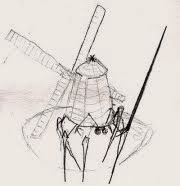Reading paper tape is relatively easy. I've settled on a bank of 'bump sensors' set below the tape. On every third 'heartbeat' tick, the tape is drawn forward one notch, and a set of plungers are bounced with a piano hammer style mechanism against the tape. Where their are holes, a plunger goes through, and triggers the appropiate sensor.
Writing to tape isn't much harder; the plungers have to be solidly built, and driven with a fair amount of force to punch the holes. Nothing impossible.
Now if I could get magical self-healing tape, than I could do reads and writes on the same paper.
Writing on one tape, and reading on the other is monotonous.
Even if I wrote data on the tape backwards from point X, and read program data forwards from point X, the machine will still spend a lot of time spinning tape. Not to mention the overhead in RAM for all the data pointers.
RAM...RAM...RAM...Curse'd RAM...harder to implement than vision. Curs'd, vile, wick'd inquitious RAM !
... Early scrolls could be seen as a form of paper tape, with optical readers, and a reel on each end of the scroll. Of course, the ancients never seem to have invented the cassette to protect the scrolls.
Books - a sector formatted Random Acsess Format - has proved much more useful.


No comments:
Post a Comment